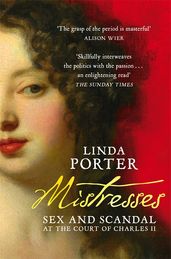Royal renegades: the forgotten children of Charles I
We introduce the main protagonists of Linda Porter's Royal Renegades, the six heirs of the doomed king, Charles I.

The fact that the English Civil War led to the execution of King Charles I in January 1649 is well known, as is the restoration of his eldest son as Charles II eleven years later. But what happened to the king's other surviving children is far less familiar.
Linda Porter's Royal Renegades charts the fascinating story of what became of them when their calm and loving family life was shattered by the Civil War and the execution of their father.
We introduce the main protagonists of Linda Porter's Royal Renegades, the six heirs of the doomed king, Charles I.

Charles I and his unpopular French wife, Henrietta Maria, had nine children in all, of whom five were still alive at the outbreak of civil war in 1642: Charles, Prince of Wales (b.1630), Mary, Princess Royal, (b.1631), James, duke of York, (b.1633), Elizabeth, (b. 1635) and Henry, duke of Gloucester (b.1640).
Their family would be divided and ultimately destroyed. But not before a final child, Princess Henrietta, was born in Exeter in 1644, as her mother sought shelter from the encircling Parliamentarian armies.
Charles, Prince of Wales
Charles I was nothing if not a dynast and his entire focus, once war broke out, was on his eldest son and heir. Prince Charles stayed with him till 1645, eventually escaping to France the following year, to join his mother.
In 1650, Charles invaded England with a Scottish army but was defeated by Cromwell at the Battle of Worcester in 1651. He again escaped into exile, but in 1660 Charles was invited back to England to reclaim his throne as Charles II of England and Scotland. He entered London to cheering crowds on his thirtieth birthday, 29 May 1660.
Mary, Princess Royal
In March 1642, before the first shot of the Civil Wars had been fired, twelve-year-old Mary was whisked away to the Netherlands as the child bride of the Prince of Orange. William was a good-looking and well-educated boy of fifteen and the pair seem to have genuinely liked each other, however, Mary never learned to speak Dutch and did not enjoy living the Dutch Republic. William became head of the House of Orange as William II following the death of his father, Frederick Henry, at the end of 1647 and Mary became the first lady of the Netherlands. William was a main supporter of the future Charles II and the future James II in exile. He died of smallpox on 6 November 1650, just 24 years old, and the couple's only child, Willem, was born a few days later.
Mary received her three brothers in exile. Her siblings would be heavily dependent on the loyalty, love and support of their sister until the restoration of Charles II in England and Scotland in 1660. In September of that year, Mary returned to England but died of smallpox on 24 December 1660, at the age of 29. Her only son William later became William III, who ruled jointly with his cousin Mary.
James, Duke of York
During the Civil War, James, duke of York and the second son of Charles I, lived in Oxford until the city surrendered in June 1646. He was then removed by order of Parliament to St. James’s Palace where he was held with his younger sister, Elizabeth, and brother, Henry. With his father imprisoned and his older brother on the run, James was seen as a serious candidate for the Crown, however, in April 1648 he escaped to the Netherlands and joined his mother in exile. He distinguished himself a soldier in the French and Spanish armies, eventually returning to England at the Restoration of his brother, Charles II, in 1660.
He commanded the Royal Navy from 1660 to 1673. In 1660, James married Anne Hyde, daughter of Charles II's chief minister and they had two surviving children, Mary and Anne. In 1669, James converted to Catholicism and took a stand against a number of anti-Catholic moves but this did not impede his succession to the throne on Charles' death in 1685. James II ruled Britain for just five years before he was defeated by his Protestant nephew, William of Orange, at the Battle of the Boyne in July 1690. William ruled jointly with his wife Mary, James's daughter, and James died in exile in France in 1701.
Elizabeth Stuart
Elizabeth, along with her brother Henry, was used as a pawn in the parliamentary campaign against her father and from the age of six was a prisoner of Parliament at St. James’s Palace and Syon House. She helped her brother James to escape to exile. After her father was sentenced to death in 1649, Elizabeth wrote a letter to parliament asking permission to join her sister Mary in the Netherlands but her request was deferred until after the execution.
Her brother Charles’ attempted invasion of England had devastating consequences for Elizabeth. The failed attack alarmed Parliament who moved Elizabeth and Henry to Carisbrooke Castle on the Isle of Wight, despite Elizabeth’s poor health. Within a week of her arrival on the island, Elizabeth had developed pneumonia and she died on 8 September 1650. In a supreme irony, it was reported to parliament on 11 September that the Council of State had, at last, conceded that Elizabeth should be permitted to leave England to live with Mary.
Henry, Duke of Gloucester
Prince Henry stayed on at Carisbrooke Castle with his tutor and his few servants for two and a half years after the death of Princess Elizabeth. From the middle of 1652 Henry renewed his plea to the Council of State for permission to join his sister, Mary, in Holland. Finally, in December 1652, permission was given and on 12 February the young prince set sail from Cowes. Mary wished fervently to keep her little brother with her indefinitely. Sadly, scarcely a month later, it was made clear by Charles II that his youngest brother must come to Paris. Their mother, Henrietta Maria, had not seen Henry since 1641 and he felt it wrong to deny her request to have the boy by her side.
Henry arrived in the French capital in May 1653. He had no memory of his mother and was disconcerted by this small, fierce, French-speaking woman. Her plans for him caused the greatest crisis and sorrow he had yet faced.
Henry’s mother was unrelenting in her attempts to convert her youngest son to Catholicism, against the wishes of his two older brothers. Henry remained true to his father and brother, and to his own convictions. He had endured much in his short life and was more than a match for a mother who believed that her maternal duty to save her son’s soul. Eventually Henrietta Maria disowned her son, forcing him to leave France. Henry join the Spanish armies at Dunkirk and fought alongside his brother James, the Duke of York. He distinguished himself in battle, and gradually gained a reputation as one of Europe's foremost Protestant soldiers. He returned to England as part of Charles' triumphant progress through London in May 1660.
At the beginning of September 1660, Henry contracted smallpox. His condition was thought initially to be relatively mild and his recovery was expected, however, he died on 13 September, to the great shock of his family.
Princess Henrietta Anne
A few weeks before the birth of Henrietta, her mother had been forced to flee Oxford for Exeter and it was rumoured that she was unlikely to survive the birth due to her poor health. After the birth the infant Henrietta Anne was placed in the care of Anne Villiers, Lady Dalkeith. The queen returned to France to solicit aid for her husband's cause from her powerful nephew, King Louis XIV. When the order came from the House of Commons for Princess Henrietta to join Elizabeth and Henry at St James’s, her intrepid governess, determined to resist this development, took matters into her own hands.
On 25 July 1646, she set out on foot to Dover, intending to take a boat for France. Princess Henrietta was dressed in rough clothing and disguised as a boy. They reached Dover without impediment and crossed to France, where they were met by the princess’s mother who was overjoyed by this unexpected development. Princess Henrietta, now known by the French names of Henriette Anne, was brought up in the Catholic faith despite her father’s commands, and very much under the thumb of her mother.
Henriette Anne eventually married the French heir, Philippe of Anjou, in March 1661. She would soon discover that her elevation to the position of second lady of France was bought at a terrible price; Philippe was a cruel and jealous husband. Henriette Anne was almost continuously pregnant through-out her scandalous and loveless marriage. Only her first child, Marie-Louise and her last, Anne-Marie survived. In between, she had to put up with stillbirths, life-threatening miscarriages and the death of the couple’s only son in infancy. Philippe’s jealousy was such that frequently impregnating his wife, despite her increasing ill health, was a way of limiting her supposed amours, as well as allowing him to exercise ultimate control in their relationship.
After her marriage Henriette Anne played an important diplomatic role in negotiations between England and France. Against her husband’s wishes she travelled to England in 1670 to visit her beloved brother Charles and to witness the signing of the Secret Treaty of Dover. Soon after her return to France, on a trip to Versailles, Henriette Anne asked for the drink of iced chicory water which had a catastrophic effect. No sooner had she drunk it than she collapsed in agony, clutching her side and crying out: ‘Oh, what a cramp in my side! What pain!’ Her immediate thought was that the drink had been poisoned.
She died on 30th June, aged twenty-six. The general consensus is that Henriette Anne died of peritonitis caused by a perforated duodenal ulcer and that she may have been further weakened by tuberculosis.
Discover the full story of the Renegades with Linda Porter's fascinating accounts of Charles I's doomed heirs:
Royal Renegades

A tale of love and endurance, of battles and flight, of educations disrupted, the lonely death of a young princess and the wearisome experience of exile, Royal Renegades charts the fascinating story of the children of loving parents who could not protect them from the consequences of their own failings as monarchs and the forces of upheaval sweeping England.
Mistresses
by Linda Porter
Charles II ruled over a hedonistic court, and was described as being ‘addicted to women’, many who succumbed to his charms. In Mistresses, Linda Porter tells the story of the women who shared Charles’s bed, painting a vivid picture of both these women and of Restoration England, an era that was both glamorous and sordid.



